Business Law Essay: Leichhardt Council, Business Ethics, Banking Code
VerifiedAdded on 2020/05/11
|13
|3647
|91
Essay
AI Summary
This essay examines key concepts in business law, focusing on the case of Leichhardt Municipal Council v Montgomery, exploring the council's duty of care as a road authority and its potential breach of this duty. The essay then delves into business ethics, defining it as the application of ethical principles in a business context, referencing biblical verses to illustrate the importance of ethical conduct, and analyzing a case study involving unethical behavior. It further discusses ethical codes in Australia, using the 7-Eleven case as an example of unethical conduct and the National Australia Bank as an example of an ethical company. Finally, the essay addresses the Code of Banking Practice in Australia, focusing on its significance, compliance, and legal obligations, referencing the case of National Australia Bank Ltd v John Albert Rose [2016] VSCA 169 to illustrate these obligations.

Paraphrase This Document
Need a fresh take? Get an instant paraphrase of this document with our AI Paraphraser
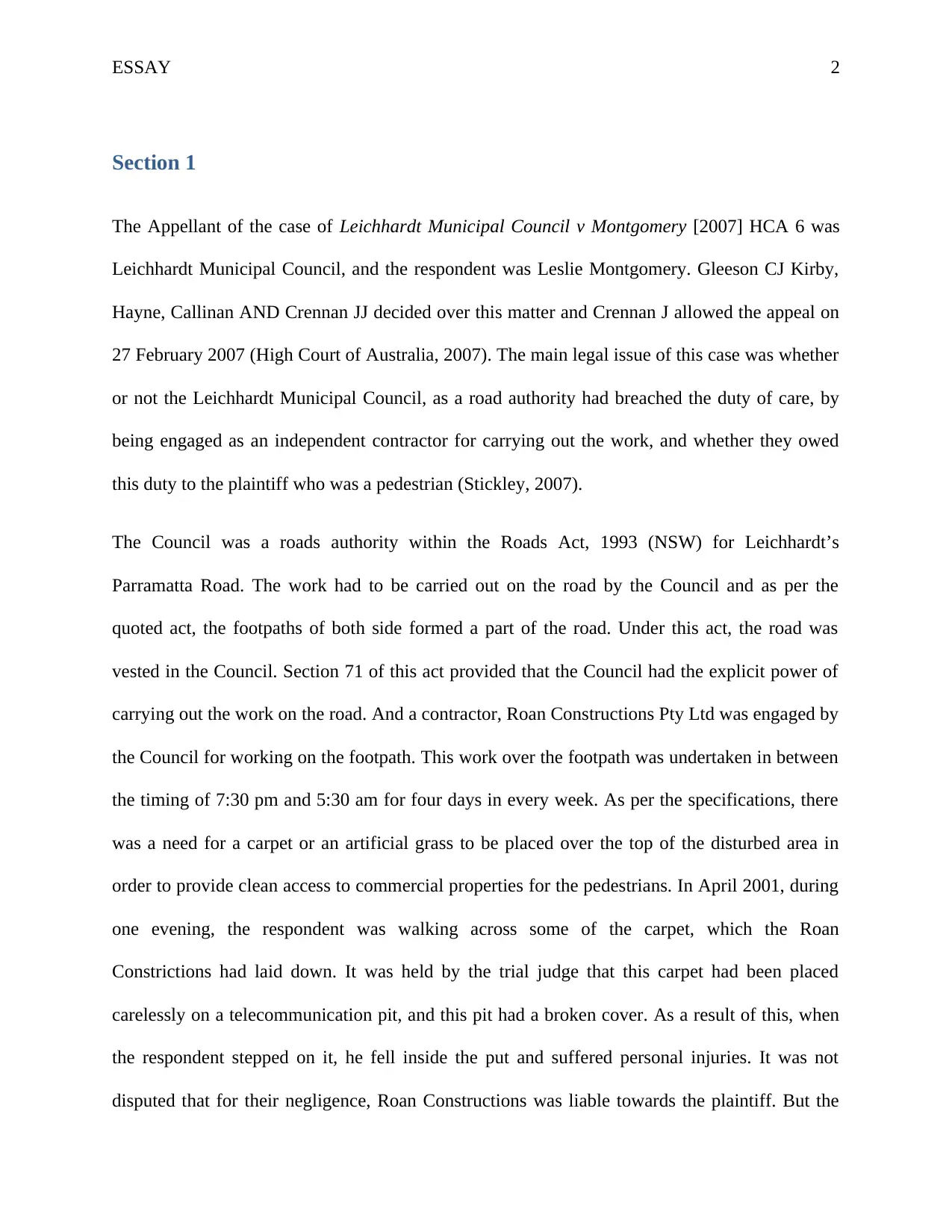
ESSAY 2
Section 1
The Appellant of the case of Leichhardt Municipal Council v Montgomery [2007] HCA 6 was
Leichhardt Municipal Council, and the respondent was Leslie Montgomery. Gleeson CJ Kirby,
Hayne, Callinan AND Crennan JJ decided over this matter and Crennan J allowed the appeal on
27 February 2007 (High Court of Australia, 2007). The main legal issue of this case was whether
or not the Leichhardt Municipal Council, as a road authority had breached the duty of care, by
being engaged as an independent contractor for carrying out the work, and whether they owed
this duty to the plaintiff who was a pedestrian (Stickley, 2007).
The Council was a roads authority within the Roads Act, 1993 (NSW) for Leichhardt’s
Parramatta Road. The work had to be carried out on the road by the Council and as per the
quoted act, the footpaths of both side formed a part of the road. Under this act, the road was
vested in the Council. Section 71 of this act provided that the Council had the explicit power of
carrying out the work on the road. And a contractor, Roan Constructions Pty Ltd was engaged by
the Council for working on the footpath. This work over the footpath was undertaken in between
the timing of 7:30 pm and 5:30 am for four days in every week. As per the specifications, there
was a need for a carpet or an artificial grass to be placed over the top of the disturbed area in
order to provide clean access to commercial properties for the pedestrians. In April 2001, during
one evening, the respondent was walking across some of the carpet, which the Roan
Constrictions had laid down. It was held by the trial judge that this carpet had been placed
carelessly on a telecommunication pit, and this pit had a broken cover. As a result of this, when
the respondent stepped on it, he fell inside the put and suffered personal injuries. It was not
disputed that for their negligence, Roan Constructions was liable towards the plaintiff. But the
Section 1
The Appellant of the case of Leichhardt Municipal Council v Montgomery [2007] HCA 6 was
Leichhardt Municipal Council, and the respondent was Leslie Montgomery. Gleeson CJ Kirby,
Hayne, Callinan AND Crennan JJ decided over this matter and Crennan J allowed the appeal on
27 February 2007 (High Court of Australia, 2007). The main legal issue of this case was whether
or not the Leichhardt Municipal Council, as a road authority had breached the duty of care, by
being engaged as an independent contractor for carrying out the work, and whether they owed
this duty to the plaintiff who was a pedestrian (Stickley, 2007).
The Council was a roads authority within the Roads Act, 1993 (NSW) for Leichhardt’s
Parramatta Road. The work had to be carried out on the road by the Council and as per the
quoted act, the footpaths of both side formed a part of the road. Under this act, the road was
vested in the Council. Section 71 of this act provided that the Council had the explicit power of
carrying out the work on the road. And a contractor, Roan Constructions Pty Ltd was engaged by
the Council for working on the footpath. This work over the footpath was undertaken in between
the timing of 7:30 pm and 5:30 am for four days in every week. As per the specifications, there
was a need for a carpet or an artificial grass to be placed over the top of the disturbed area in
order to provide clean access to commercial properties for the pedestrians. In April 2001, during
one evening, the respondent was walking across some of the carpet, which the Roan
Constrictions had laid down. It was held by the trial judge that this carpet had been placed
carelessly on a telecommunication pit, and this pit had a broken cover. As a result of this, when
the respondent stepped on it, he fell inside the put and suffered personal injuries. It was not
disputed that for their negligence, Roan Constructions was liable towards the plaintiff. But the
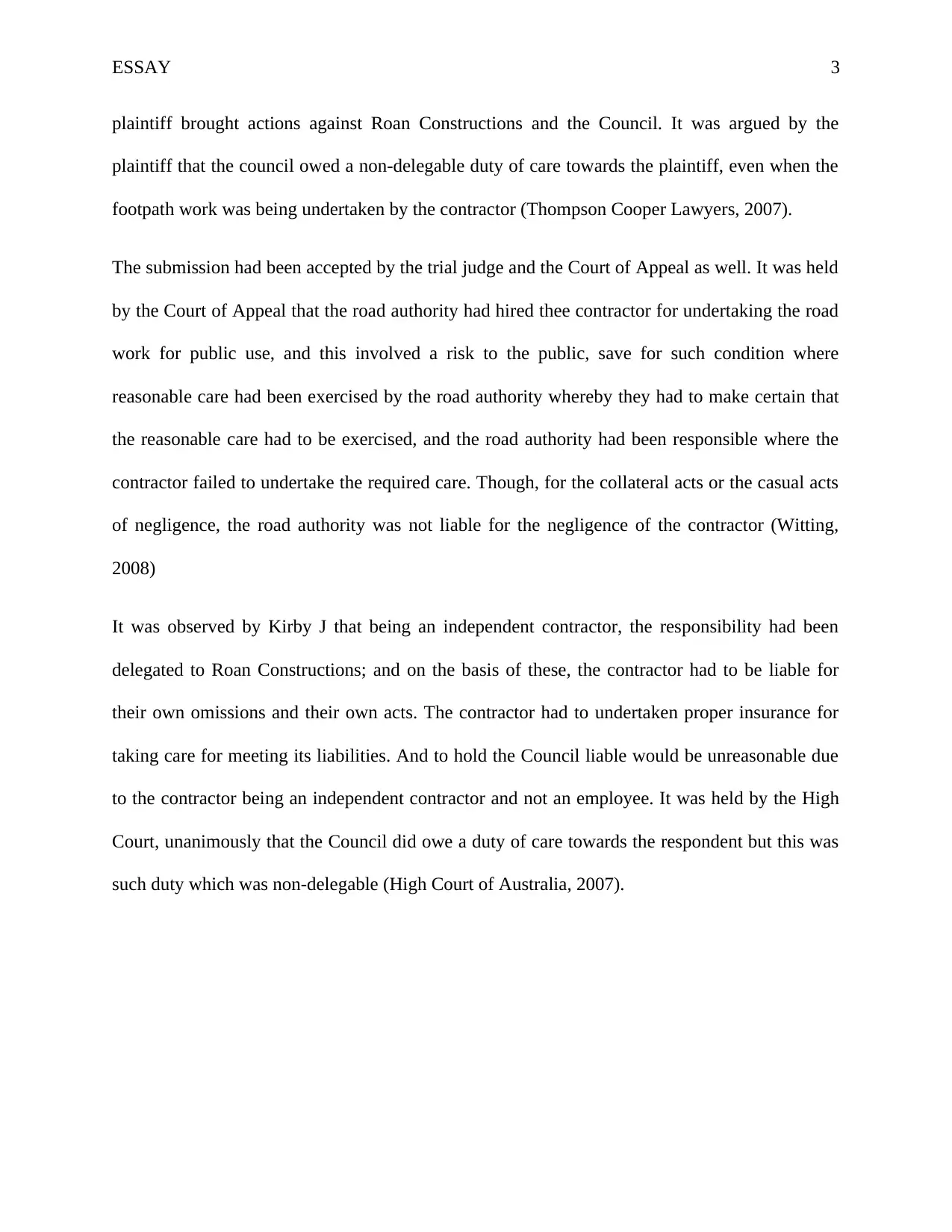
ESSAY 3
plaintiff brought actions against Roan Constructions and the Council. It was argued by the
plaintiff that the council owed a non-delegable duty of care towards the plaintiff, even when the
footpath work was being undertaken by the contractor (Thompson Cooper Lawyers, 2007).
The submission had been accepted by the trial judge and the Court of Appeal as well. It was held
by the Court of Appeal that the road authority had hired thee contractor for undertaking the road
work for public use, and this involved a risk to the public, save for such condition where
reasonable care had been exercised by the road authority whereby they had to make certain that
the reasonable care had to be exercised, and the road authority had been responsible where the
contractor failed to undertake the required care. Though, for the collateral acts or the casual acts
of negligence, the road authority was not liable for the negligence of the contractor (Witting,
2008)
It was observed by Kirby J that being an independent contractor, the responsibility had been
delegated to Roan Constructions; and on the basis of these, the contractor had to be liable for
their own omissions and their own acts. The contractor had to undertaken proper insurance for
taking care for meeting its liabilities. And to hold the Council liable would be unreasonable due
to the contractor being an independent contractor and not an employee. It was held by the High
Court, unanimously that the Council did owe a duty of care towards the respondent but this was
such duty which was non-delegable (High Court of Australia, 2007).
plaintiff brought actions against Roan Constructions and the Council. It was argued by the
plaintiff that the council owed a non-delegable duty of care towards the plaintiff, even when the
footpath work was being undertaken by the contractor (Thompson Cooper Lawyers, 2007).
The submission had been accepted by the trial judge and the Court of Appeal as well. It was held
by the Court of Appeal that the road authority had hired thee contractor for undertaking the road
work for public use, and this involved a risk to the public, save for such condition where
reasonable care had been exercised by the road authority whereby they had to make certain that
the reasonable care had to be exercised, and the road authority had been responsible where the
contractor failed to undertake the required care. Though, for the collateral acts or the casual acts
of negligence, the road authority was not liable for the negligence of the contractor (Witting,
2008)
It was observed by Kirby J that being an independent contractor, the responsibility had been
delegated to Roan Constructions; and on the basis of these, the contractor had to be liable for
their own omissions and their own acts. The contractor had to undertaken proper insurance for
taking care for meeting its liabilities. And to hold the Council liable would be unreasonable due
to the contractor being an independent contractor and not an employee. It was held by the High
Court, unanimously that the Council did owe a duty of care towards the respondent but this was
such duty which was non-delegable (High Court of Australia, 2007).
⊘ This is a preview!⊘
Do you want full access?
Subscribe today to unlock all pages.

Trusted by 1+ million students worldwide
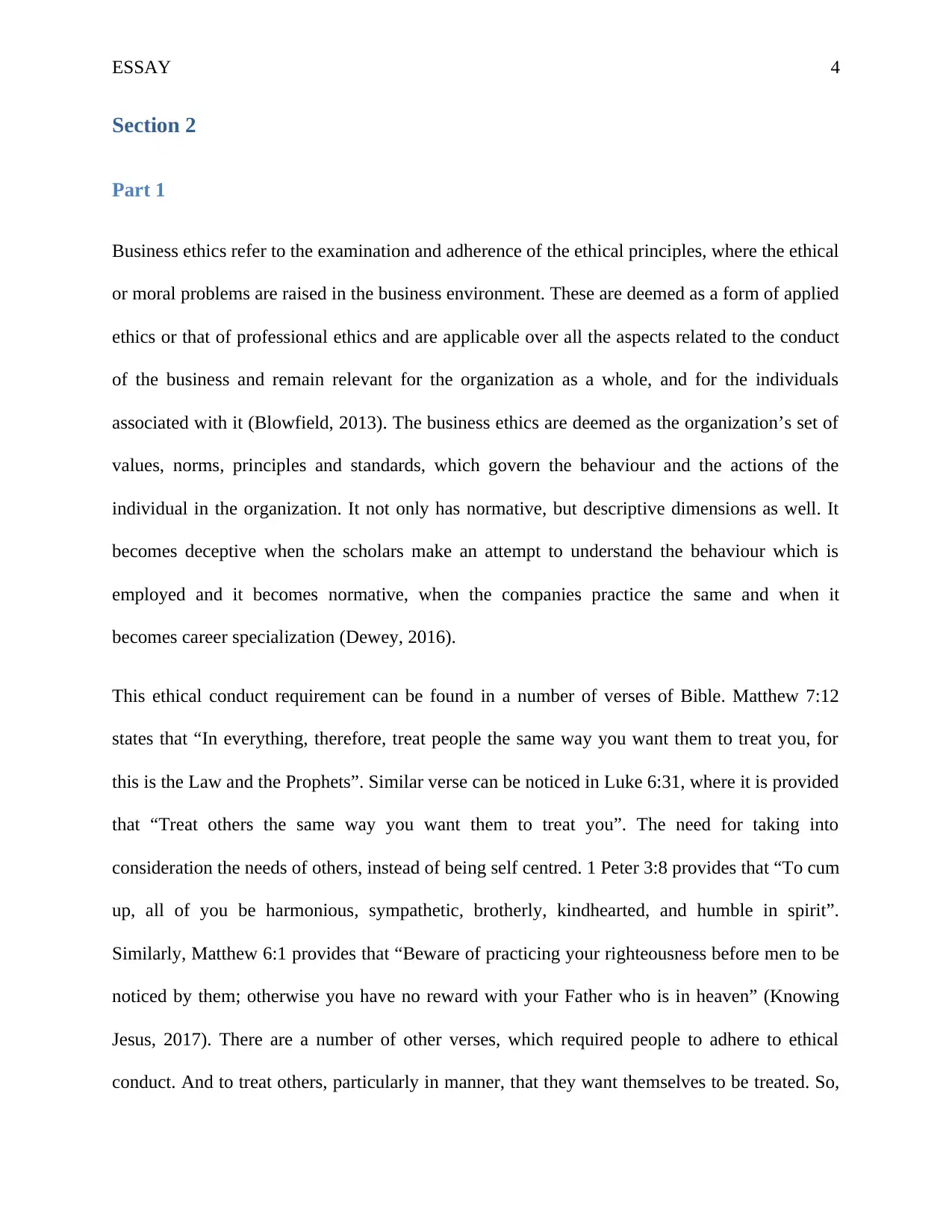
ESSAY 4
Section 2
Part 1
Business ethics refer to the examination and adherence of the ethical principles, where the ethical
or moral problems are raised in the business environment. These are deemed as a form of applied
ethics or that of professional ethics and are applicable over all the aspects related to the conduct
of the business and remain relevant for the organization as a whole, and for the individuals
associated with it (Blowfield, 2013). The business ethics are deemed as the organization’s set of
values, norms, principles and standards, which govern the behaviour and the actions of the
individual in the organization. It not only has normative, but descriptive dimensions as well. It
becomes deceptive when the scholars make an attempt to understand the behaviour which is
employed and it becomes normative, when the companies practice the same and when it
becomes career specialization (Dewey, 2016).
This ethical conduct requirement can be found in a number of verses of Bible. Matthew 7:12
states that “In everything, therefore, treat people the same way you want them to treat you, for
this is the Law and the Prophets”. Similar verse can be noticed in Luke 6:31, where it is provided
that “Treat others the same way you want them to treat you”. The need for taking into
consideration the needs of others, instead of being self centred. 1 Peter 3:8 provides that “To cum
up, all of you be harmonious, sympathetic, brotherly, kindhearted, and humble in spirit”.
Similarly, Matthew 6:1 provides that “Beware of practicing your righteousness before men to be
noticed by them; otherwise you have no reward with your Father who is in heaven” (Knowing
Jesus, 2017). There are a number of other verses, which required people to adhere to ethical
conduct. And to treat others, particularly in manner, that they want themselves to be treated. So,
Section 2
Part 1
Business ethics refer to the examination and adherence of the ethical principles, where the ethical
or moral problems are raised in the business environment. These are deemed as a form of applied
ethics or that of professional ethics and are applicable over all the aspects related to the conduct
of the business and remain relevant for the organization as a whole, and for the individuals
associated with it (Blowfield, 2013). The business ethics are deemed as the organization’s set of
values, norms, principles and standards, which govern the behaviour and the actions of the
individual in the organization. It not only has normative, but descriptive dimensions as well. It
becomes deceptive when the scholars make an attempt to understand the behaviour which is
employed and it becomes normative, when the companies practice the same and when it
becomes career specialization (Dewey, 2016).
This ethical conduct requirement can be found in a number of verses of Bible. Matthew 7:12
states that “In everything, therefore, treat people the same way you want them to treat you, for
this is the Law and the Prophets”. Similar verse can be noticed in Luke 6:31, where it is provided
that “Treat others the same way you want them to treat you”. The need for taking into
consideration the needs of others, instead of being self centred. 1 Peter 3:8 provides that “To cum
up, all of you be harmonious, sympathetic, brotherly, kindhearted, and humble in spirit”.
Similarly, Matthew 6:1 provides that “Beware of practicing your righteousness before men to be
noticed by them; otherwise you have no reward with your Father who is in heaven” (Knowing
Jesus, 2017). There are a number of other verses, which required people to adhere to ethical
conduct. And to treat others, particularly in manner, that they want themselves to be treated. So,
Paraphrase This Document
Need a fresh take? Get an instant paraphrase of this document with our AI Paraphraser
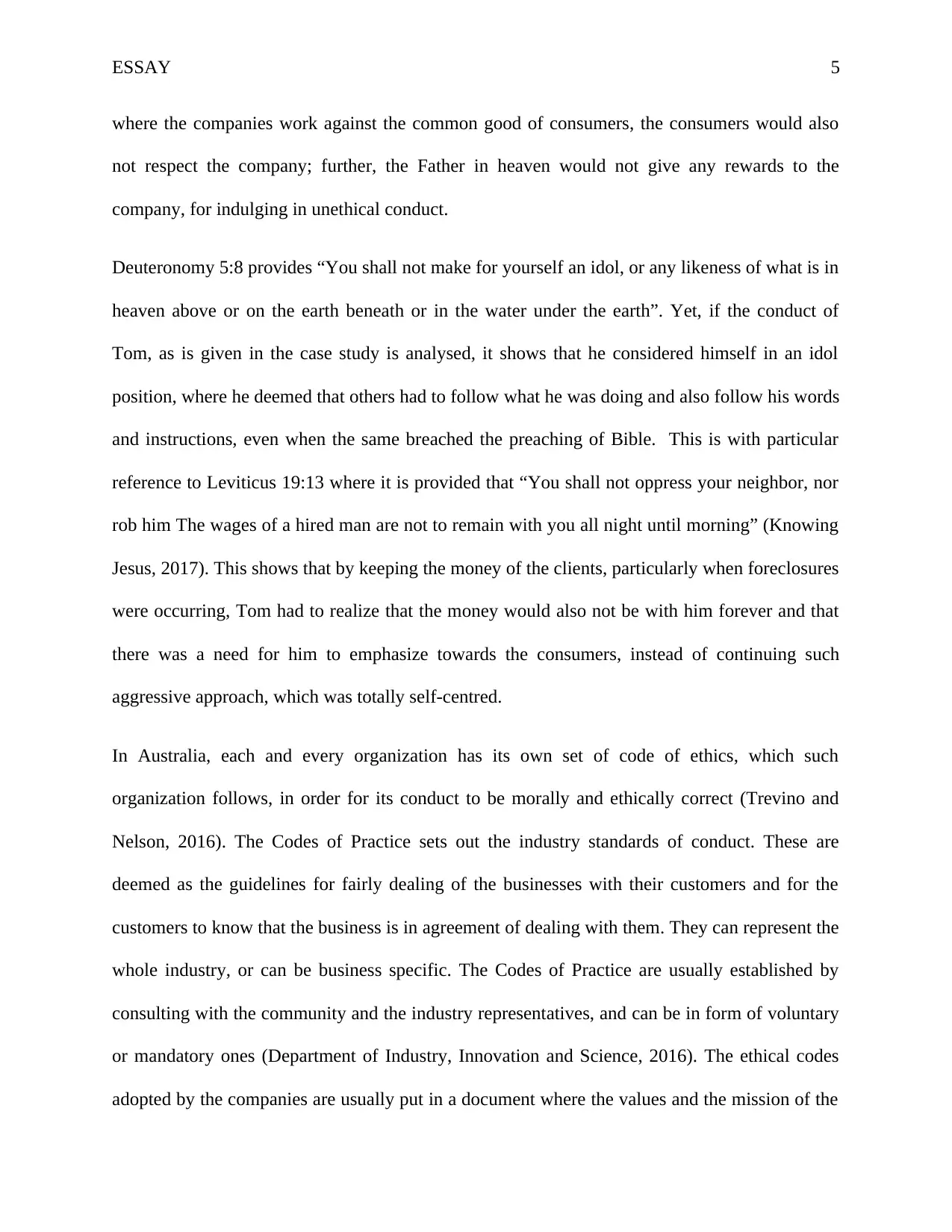
ESSAY 5
where the companies work against the common good of consumers, the consumers would also
not respect the company; further, the Father in heaven would not give any rewards to the
company, for indulging in unethical conduct.
Deuteronomy 5:8 provides “You shall not make for yourself an idol, or any likeness of what is in
heaven above or on the earth beneath or in the water under the earth”. Yet, if the conduct of
Tom, as is given in the case study is analysed, it shows that he considered himself in an idol
position, where he deemed that others had to follow what he was doing and also follow his words
and instructions, even when the same breached the preaching of Bible. This is with particular
reference to Leviticus 19:13 where it is provided that “You shall not oppress your neighbor, nor
rob him The wages of a hired man are not to remain with you all night until morning” (Knowing
Jesus, 2017). This shows that by keeping the money of the clients, particularly when foreclosures
were occurring, Tom had to realize that the money would also not be with him forever and that
there was a need for him to emphasize towards the consumers, instead of continuing such
aggressive approach, which was totally self-centred.
In Australia, each and every organization has its own set of code of ethics, which such
organization follows, in order for its conduct to be morally and ethically correct (Trevino and
Nelson, 2016). The Codes of Practice sets out the industry standards of conduct. These are
deemed as the guidelines for fairly dealing of the businesses with their customers and for the
customers to know that the business is in agreement of dealing with them. They can represent the
whole industry, or can be business specific. The Codes of Practice are usually established by
consulting with the community and the industry representatives, and can be in form of voluntary
or mandatory ones (Department of Industry, Innovation and Science, 2016). The ethical codes
adopted by the companies are usually put in a document where the values and the mission of the
where the companies work against the common good of consumers, the consumers would also
not respect the company; further, the Father in heaven would not give any rewards to the
company, for indulging in unethical conduct.
Deuteronomy 5:8 provides “You shall not make for yourself an idol, or any likeness of what is in
heaven above or on the earth beneath or in the water under the earth”. Yet, if the conduct of
Tom, as is given in the case study is analysed, it shows that he considered himself in an idol
position, where he deemed that others had to follow what he was doing and also follow his words
and instructions, even when the same breached the preaching of Bible. This is with particular
reference to Leviticus 19:13 where it is provided that “You shall not oppress your neighbor, nor
rob him The wages of a hired man are not to remain with you all night until morning” (Knowing
Jesus, 2017). This shows that by keeping the money of the clients, particularly when foreclosures
were occurring, Tom had to realize that the money would also not be with him forever and that
there was a need for him to emphasize towards the consumers, instead of continuing such
aggressive approach, which was totally self-centred.
In Australia, each and every organization has its own set of code of ethics, which such
organization follows, in order for its conduct to be morally and ethically correct (Trevino and
Nelson, 2016). The Codes of Practice sets out the industry standards of conduct. These are
deemed as the guidelines for fairly dealing of the businesses with their customers and for the
customers to know that the business is in agreement of dealing with them. They can represent the
whole industry, or can be business specific. The Codes of Practice are usually established by
consulting with the community and the industry representatives, and can be in form of voluntary
or mandatory ones (Department of Industry, Innovation and Science, 2016). The ethical codes
adopted by the companies are usually put in a document where the values and the mission of the
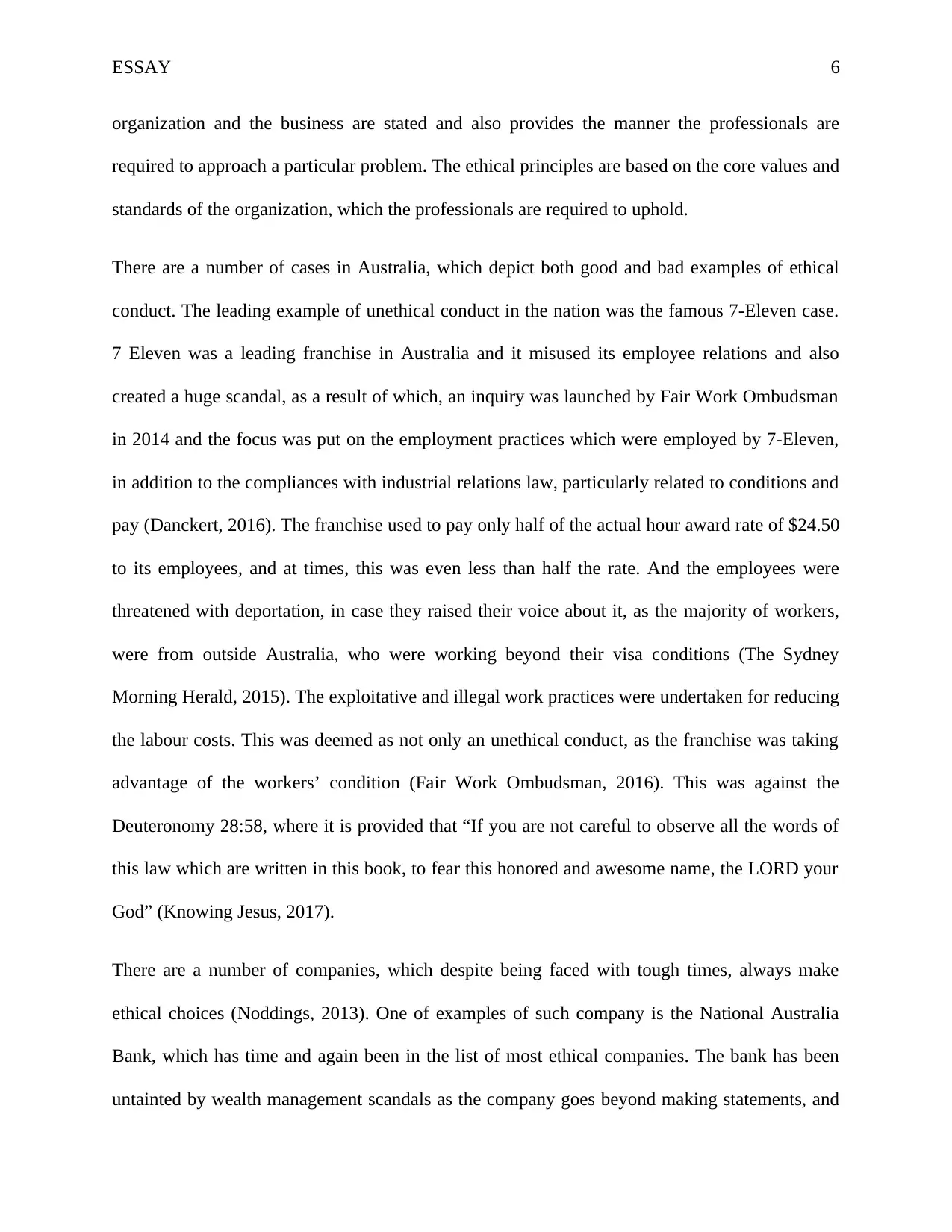
ESSAY 6
organization and the business are stated and also provides the manner the professionals are
required to approach a particular problem. The ethical principles are based on the core values and
standards of the organization, which the professionals are required to uphold.
There are a number of cases in Australia, which depict both good and bad examples of ethical
conduct. The leading example of unethical conduct in the nation was the famous 7-Eleven case.
7 Eleven was a leading franchise in Australia and it misused its employee relations and also
created a huge scandal, as a result of which, an inquiry was launched by Fair Work Ombudsman
in 2014 and the focus was put on the employment practices which were employed by 7-Eleven,
in addition to the compliances with industrial relations law, particularly related to conditions and
pay (Danckert, 2016). The franchise used to pay only half of the actual hour award rate of $24.50
to its employees, and at times, this was even less than half the rate. And the employees were
threatened with deportation, in case they raised their voice about it, as the majority of workers,
were from outside Australia, who were working beyond their visa conditions (The Sydney
Morning Herald, 2015). The exploitative and illegal work practices were undertaken for reducing
the labour costs. This was deemed as not only an unethical conduct, as the franchise was taking
advantage of the workers’ condition (Fair Work Ombudsman, 2016). This was against the
Deuteronomy 28:58, where it is provided that “If you are not careful to observe all the words of
this law which are written in this book, to fear this honored and awesome name, the LORD your
God” (Knowing Jesus, 2017).
There are a number of companies, which despite being faced with tough times, always make
ethical choices (Noddings, 2013). One of examples of such company is the National Australia
Bank, which has time and again been in the list of most ethical companies. The bank has been
untainted by wealth management scandals as the company goes beyond making statements, and
organization and the business are stated and also provides the manner the professionals are
required to approach a particular problem. The ethical principles are based on the core values and
standards of the organization, which the professionals are required to uphold.
There are a number of cases in Australia, which depict both good and bad examples of ethical
conduct. The leading example of unethical conduct in the nation was the famous 7-Eleven case.
7 Eleven was a leading franchise in Australia and it misused its employee relations and also
created a huge scandal, as a result of which, an inquiry was launched by Fair Work Ombudsman
in 2014 and the focus was put on the employment practices which were employed by 7-Eleven,
in addition to the compliances with industrial relations law, particularly related to conditions and
pay (Danckert, 2016). The franchise used to pay only half of the actual hour award rate of $24.50
to its employees, and at times, this was even less than half the rate. And the employees were
threatened with deportation, in case they raised their voice about it, as the majority of workers,
were from outside Australia, who were working beyond their visa conditions (The Sydney
Morning Herald, 2015). The exploitative and illegal work practices were undertaken for reducing
the labour costs. This was deemed as not only an unethical conduct, as the franchise was taking
advantage of the workers’ condition (Fair Work Ombudsman, 2016). This was against the
Deuteronomy 28:58, where it is provided that “If you are not careful to observe all the words of
this law which are written in this book, to fear this honored and awesome name, the LORD your
God” (Knowing Jesus, 2017).
There are a number of companies, which despite being faced with tough times, always make
ethical choices (Noddings, 2013). One of examples of such company is the National Australia
Bank, which has time and again been in the list of most ethical companies. The bank has been
untainted by wealth management scandals as the company goes beyond making statements, and
⊘ This is a preview!⊘
Do you want full access?
Subscribe today to unlock all pages.

Trusted by 1+ million students worldwide
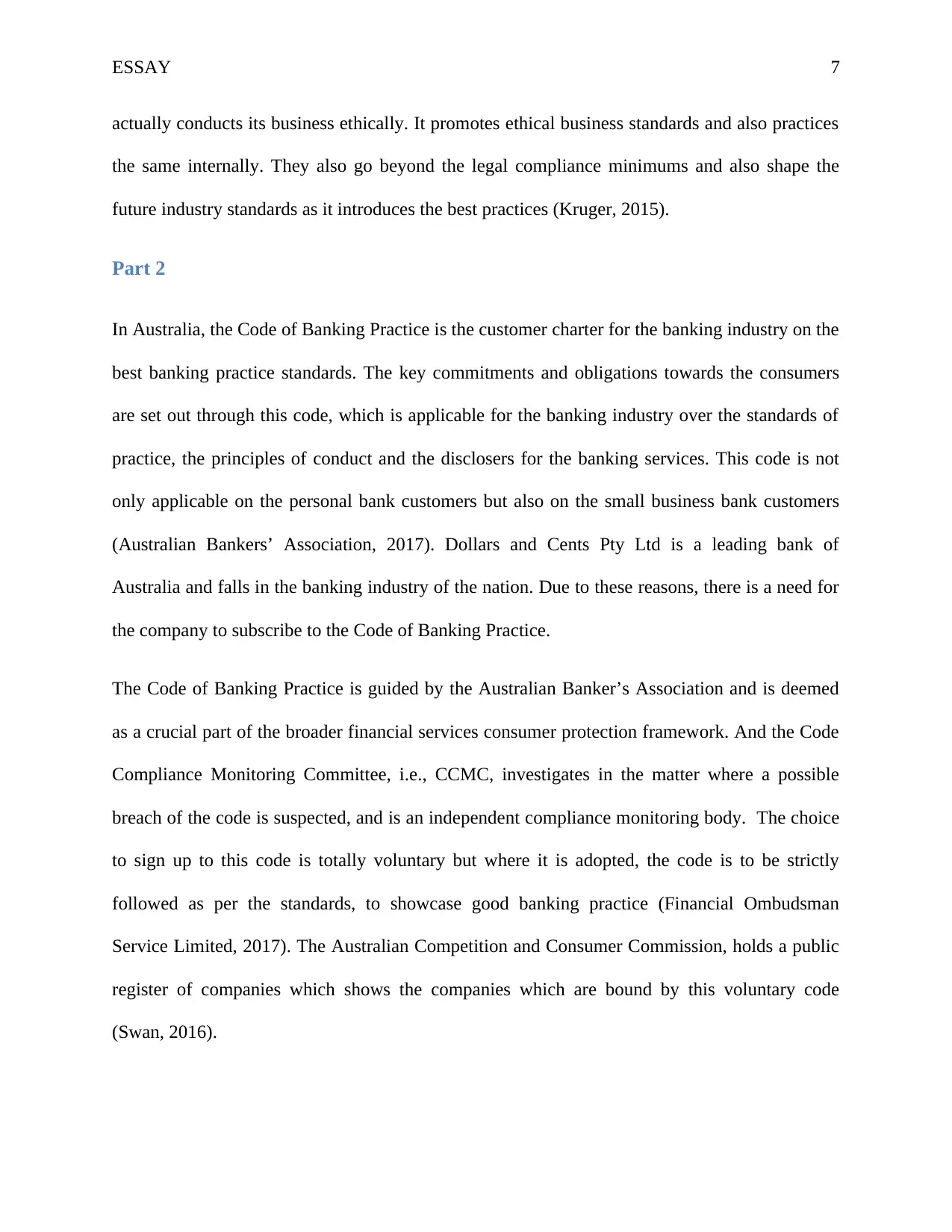
ESSAY 7
actually conducts its business ethically. It promotes ethical business standards and also practices
the same internally. They also go beyond the legal compliance minimums and also shape the
future industry standards as it introduces the best practices (Kruger, 2015).
Part 2
In Australia, the Code of Banking Practice is the customer charter for the banking industry on the
best banking practice standards. The key commitments and obligations towards the consumers
are set out through this code, which is applicable for the banking industry over the standards of
practice, the principles of conduct and the disclosers for the banking services. This code is not
only applicable on the personal bank customers but also on the small business bank customers
(Australian Bankers’ Association, 2017). Dollars and Cents Pty Ltd is a leading bank of
Australia and falls in the banking industry of the nation. Due to these reasons, there is a need for
the company to subscribe to the Code of Banking Practice.
The Code of Banking Practice is guided by the Australian Banker’s Association and is deemed
as a crucial part of the broader financial services consumer protection framework. And the Code
Compliance Monitoring Committee, i.e., CCMC, investigates in the matter where a possible
breach of the code is suspected, and is an independent compliance monitoring body. The choice
to sign up to this code is totally voluntary but where it is adopted, the code is to be strictly
followed as per the standards, to showcase good banking practice (Financial Ombudsman
Service Limited, 2017). The Australian Competition and Consumer Commission, holds a public
register of companies which shows the companies which are bound by this voluntary code
(Swan, 2016).
actually conducts its business ethically. It promotes ethical business standards and also practices
the same internally. They also go beyond the legal compliance minimums and also shape the
future industry standards as it introduces the best practices (Kruger, 2015).
Part 2
In Australia, the Code of Banking Practice is the customer charter for the banking industry on the
best banking practice standards. The key commitments and obligations towards the consumers
are set out through this code, which is applicable for the banking industry over the standards of
practice, the principles of conduct and the disclosers for the banking services. This code is not
only applicable on the personal bank customers but also on the small business bank customers
(Australian Bankers’ Association, 2017). Dollars and Cents Pty Ltd is a leading bank of
Australia and falls in the banking industry of the nation. Due to these reasons, there is a need for
the company to subscribe to the Code of Banking Practice.
The Code of Banking Practice is guided by the Australian Banker’s Association and is deemed
as a crucial part of the broader financial services consumer protection framework. And the Code
Compliance Monitoring Committee, i.e., CCMC, investigates in the matter where a possible
breach of the code is suspected, and is an independent compliance monitoring body. The choice
to sign up to this code is totally voluntary but where it is adopted, the code is to be strictly
followed as per the standards, to showcase good banking practice (Financial Ombudsman
Service Limited, 2017). The Australian Competition and Consumer Commission, holds a public
register of companies which shows the companies which are bound by this voluntary code
(Swan, 2016).
Paraphrase This Document
Need a fresh take? Get an instant paraphrase of this document with our AI Paraphraser
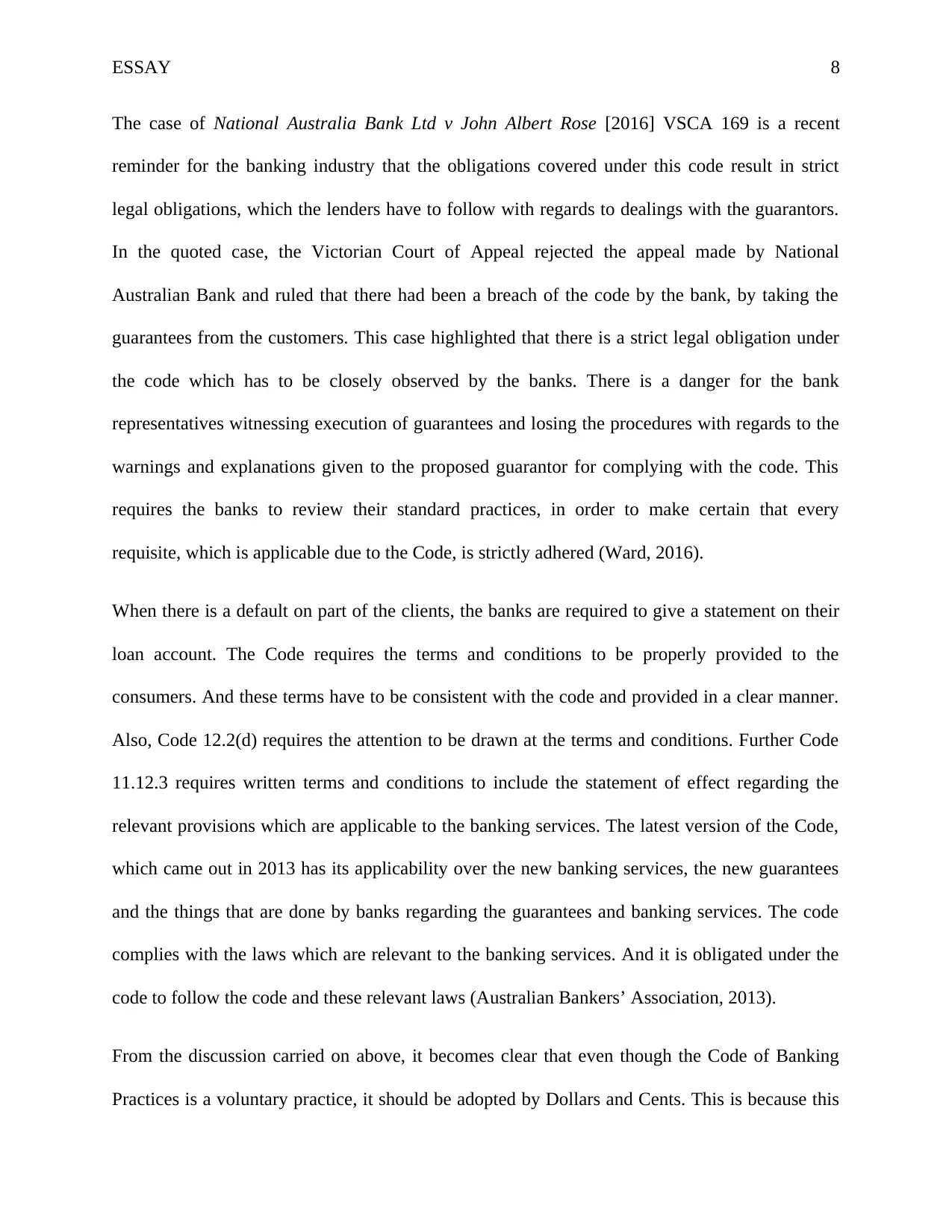
ESSAY 8
The case of National Australia Bank Ltd v John Albert Rose [2016] VSCA 169 is a recent
reminder for the banking industry that the obligations covered under this code result in strict
legal obligations, which the lenders have to follow with regards to dealings with the guarantors.
In the quoted case, the Victorian Court of Appeal rejected the appeal made by National
Australian Bank and ruled that there had been a breach of the code by the bank, by taking the
guarantees from the customers. This case highlighted that there is a strict legal obligation under
the code which has to be closely observed by the banks. There is a danger for the bank
representatives witnessing execution of guarantees and losing the procedures with regards to the
warnings and explanations given to the proposed guarantor for complying with the code. This
requires the banks to review their standard practices, in order to make certain that every
requisite, which is applicable due to the Code, is strictly adhered (Ward, 2016).
When there is a default on part of the clients, the banks are required to give a statement on their
loan account. The Code requires the terms and conditions to be properly provided to the
consumers. And these terms have to be consistent with the code and provided in a clear manner.
Also, Code 12.2(d) requires the attention to be drawn at the terms and conditions. Further Code
11.12.3 requires written terms and conditions to include the statement of effect regarding the
relevant provisions which are applicable to the banking services. The latest version of the Code,
which came out in 2013 has its applicability over the new banking services, the new guarantees
and the things that are done by banks regarding the guarantees and banking services. The code
complies with the laws which are relevant to the banking services. And it is obligated under the
code to follow the code and these relevant laws (Australian Bankers’ Association, 2013).
From the discussion carried on above, it becomes clear that even though the Code of Banking
Practices is a voluntary practice, it should be adopted by Dollars and Cents. This is because this
The case of National Australia Bank Ltd v John Albert Rose [2016] VSCA 169 is a recent
reminder for the banking industry that the obligations covered under this code result in strict
legal obligations, which the lenders have to follow with regards to dealings with the guarantors.
In the quoted case, the Victorian Court of Appeal rejected the appeal made by National
Australian Bank and ruled that there had been a breach of the code by the bank, by taking the
guarantees from the customers. This case highlighted that there is a strict legal obligation under
the code which has to be closely observed by the banks. There is a danger for the bank
representatives witnessing execution of guarantees and losing the procedures with regards to the
warnings and explanations given to the proposed guarantor for complying with the code. This
requires the banks to review their standard practices, in order to make certain that every
requisite, which is applicable due to the Code, is strictly adhered (Ward, 2016).
When there is a default on part of the clients, the banks are required to give a statement on their
loan account. The Code requires the terms and conditions to be properly provided to the
consumers. And these terms have to be consistent with the code and provided in a clear manner.
Also, Code 12.2(d) requires the attention to be drawn at the terms and conditions. Further Code
11.12.3 requires written terms and conditions to include the statement of effect regarding the
relevant provisions which are applicable to the banking services. The latest version of the Code,
which came out in 2013 has its applicability over the new banking services, the new guarantees
and the things that are done by banks regarding the guarantees and banking services. The code
complies with the laws which are relevant to the banking services. And it is obligated under the
code to follow the code and these relevant laws (Australian Bankers’ Association, 2013).
From the discussion carried on above, it becomes clear that even though the Code of Banking
Practices is a voluntary practice, it should be adopted by Dollars and Cents. This is because this
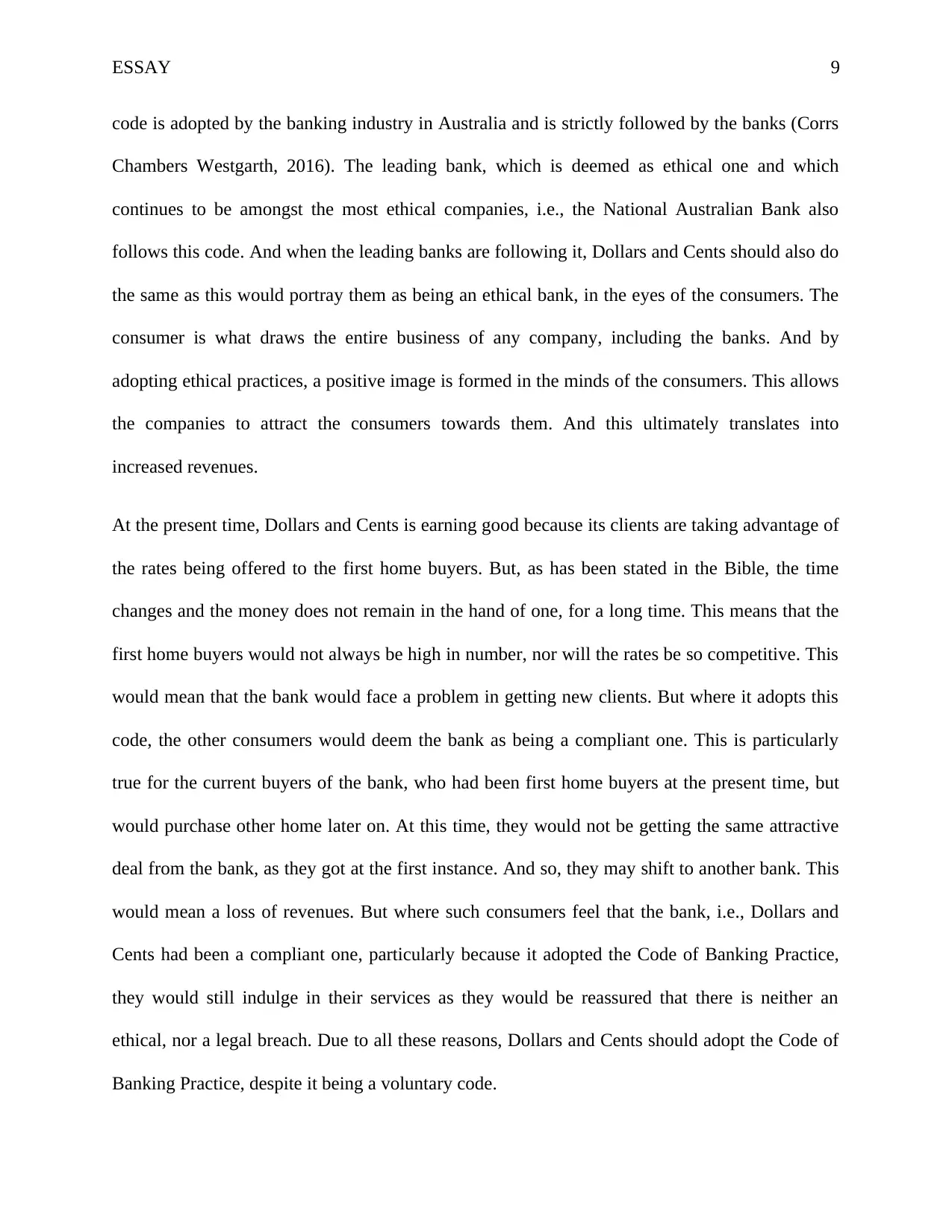
ESSAY 9
code is adopted by the banking industry in Australia and is strictly followed by the banks (Corrs
Chambers Westgarth, 2016). The leading bank, which is deemed as ethical one and which
continues to be amongst the most ethical companies, i.e., the National Australian Bank also
follows this code. And when the leading banks are following it, Dollars and Cents should also do
the same as this would portray them as being an ethical bank, in the eyes of the consumers. The
consumer is what draws the entire business of any company, including the banks. And by
adopting ethical practices, a positive image is formed in the minds of the consumers. This allows
the companies to attract the consumers towards them. And this ultimately translates into
increased revenues.
At the present time, Dollars and Cents is earning good because its clients are taking advantage of
the rates being offered to the first home buyers. But, as has been stated in the Bible, the time
changes and the money does not remain in the hand of one, for a long time. This means that the
first home buyers would not always be high in number, nor will the rates be so competitive. This
would mean that the bank would face a problem in getting new clients. But where it adopts this
code, the other consumers would deem the bank as being a compliant one. This is particularly
true for the current buyers of the bank, who had been first home buyers at the present time, but
would purchase other home later on. At this time, they would not be getting the same attractive
deal from the bank, as they got at the first instance. And so, they may shift to another bank. This
would mean a loss of revenues. But where such consumers feel that the bank, i.e., Dollars and
Cents had been a compliant one, particularly because it adopted the Code of Banking Practice,
they would still indulge in their services as they would be reassured that there is neither an
ethical, nor a legal breach. Due to all these reasons, Dollars and Cents should adopt the Code of
Banking Practice, despite it being a voluntary code.
code is adopted by the banking industry in Australia and is strictly followed by the banks (Corrs
Chambers Westgarth, 2016). The leading bank, which is deemed as ethical one and which
continues to be amongst the most ethical companies, i.e., the National Australian Bank also
follows this code. And when the leading banks are following it, Dollars and Cents should also do
the same as this would portray them as being an ethical bank, in the eyes of the consumers. The
consumer is what draws the entire business of any company, including the banks. And by
adopting ethical practices, a positive image is formed in the minds of the consumers. This allows
the companies to attract the consumers towards them. And this ultimately translates into
increased revenues.
At the present time, Dollars and Cents is earning good because its clients are taking advantage of
the rates being offered to the first home buyers. But, as has been stated in the Bible, the time
changes and the money does not remain in the hand of one, for a long time. This means that the
first home buyers would not always be high in number, nor will the rates be so competitive. This
would mean that the bank would face a problem in getting new clients. But where it adopts this
code, the other consumers would deem the bank as being a compliant one. This is particularly
true for the current buyers of the bank, who had been first home buyers at the present time, but
would purchase other home later on. At this time, they would not be getting the same attractive
deal from the bank, as they got at the first instance. And so, they may shift to another bank. This
would mean a loss of revenues. But where such consumers feel that the bank, i.e., Dollars and
Cents had been a compliant one, particularly because it adopted the Code of Banking Practice,
they would still indulge in their services as they would be reassured that there is neither an
ethical, nor a legal breach. Due to all these reasons, Dollars and Cents should adopt the Code of
Banking Practice, despite it being a voluntary code.
⊘ This is a preview!⊘
Do you want full access?
Subscribe today to unlock all pages.

Trusted by 1+ million students worldwide

ESSAY 10
Paraphrase This Document
Need a fresh take? Get an instant paraphrase of this document with our AI Paraphraser
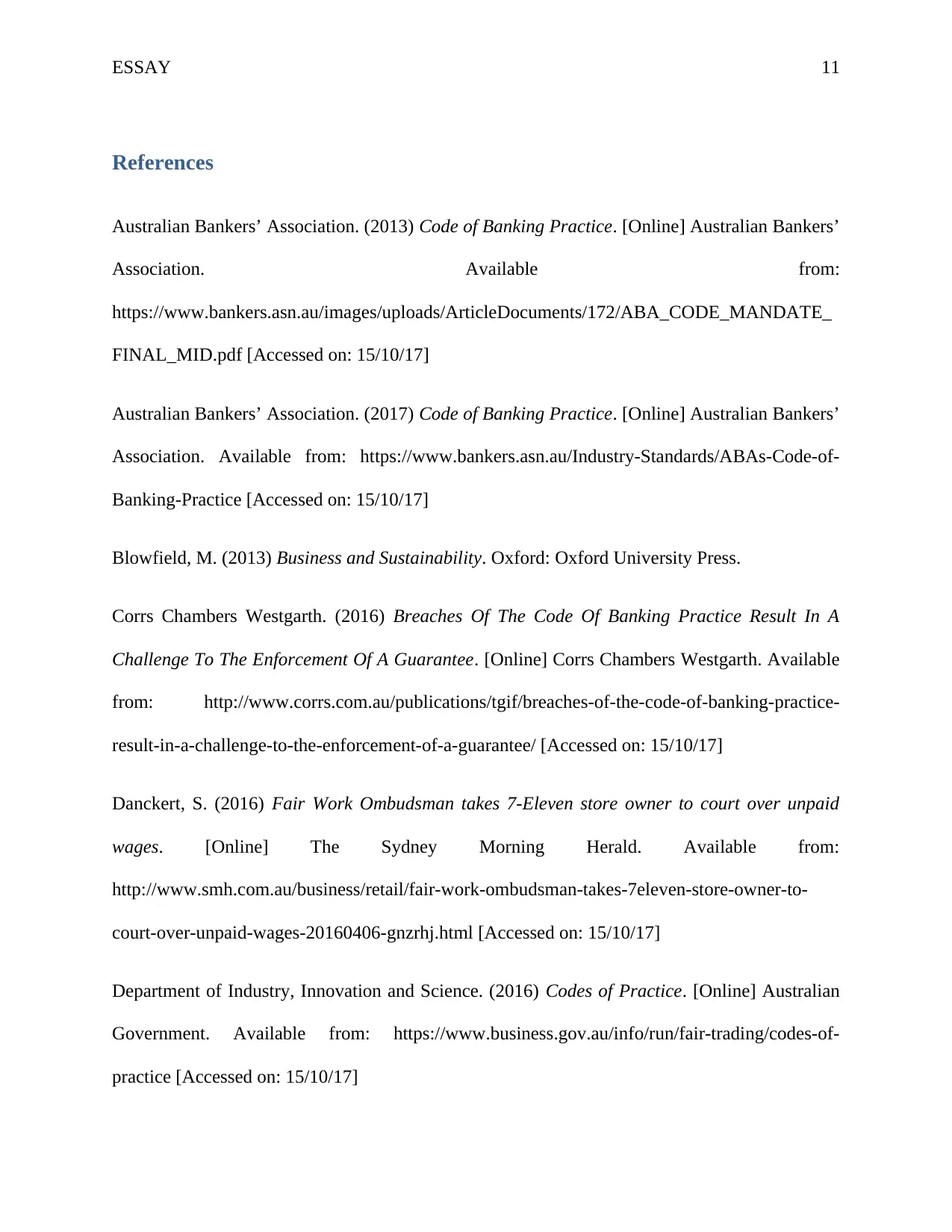
ESSAY 11
References
Australian Bankers’ Association. (2013) Code of Banking Practice. [Online] Australian Bankers’
Association. Available from:
https://www.bankers.asn.au/images/uploads/ArticleDocuments/172/ABA_CODE_MANDATE_
FINAL_MID.pdf [Accessed on: 15/10/17]
Australian Bankers’ Association. (2017) Code of Banking Practice. [Online] Australian Bankers’
Association. Available from: https://www.bankers.asn.au/Industry-Standards/ABAs-Code-of-
Banking-Practice [Accessed on: 15/10/17]
Blowfield, M. (2013) Business and Sustainability. Oxford: Oxford University Press.
Corrs Chambers Westgarth. (2016) Breaches Of The Code Of Banking Practice Result In A
Challenge To The Enforcement Of A Guarantee. [Online] Corrs Chambers Westgarth. Available
from: http://www.corrs.com.au/publications/tgif/breaches-of-the-code-of-banking-practice-
result-in-a-challenge-to-the-enforcement-of-a-guarantee/ [Accessed on: 15/10/17]
Danckert, S. (2016) Fair Work Ombudsman takes 7-Eleven store owner to court over unpaid
wages. [Online] The Sydney Morning Herald. Available from:
http://www.smh.com.au/business/retail/fair-work-ombudsman-takes-7eleven-store-owner-to-
court-over-unpaid-wages-20160406-gnzrhj.html [Accessed on: 15/10/17]
Department of Industry, Innovation and Science. (2016) Codes of Practice. [Online] Australian
Government. Available from: https://www.business.gov.au/info/run/fair-trading/codes-of-
practice [Accessed on: 15/10/17]
References
Australian Bankers’ Association. (2013) Code of Banking Practice. [Online] Australian Bankers’
Association. Available from:
https://www.bankers.asn.au/images/uploads/ArticleDocuments/172/ABA_CODE_MANDATE_
FINAL_MID.pdf [Accessed on: 15/10/17]
Australian Bankers’ Association. (2017) Code of Banking Practice. [Online] Australian Bankers’
Association. Available from: https://www.bankers.asn.au/Industry-Standards/ABAs-Code-of-
Banking-Practice [Accessed on: 15/10/17]
Blowfield, M. (2013) Business and Sustainability. Oxford: Oxford University Press.
Corrs Chambers Westgarth. (2016) Breaches Of The Code Of Banking Practice Result In A
Challenge To The Enforcement Of A Guarantee. [Online] Corrs Chambers Westgarth. Available
from: http://www.corrs.com.au/publications/tgif/breaches-of-the-code-of-banking-practice-
result-in-a-challenge-to-the-enforcement-of-a-guarantee/ [Accessed on: 15/10/17]
Danckert, S. (2016) Fair Work Ombudsman takes 7-Eleven store owner to court over unpaid
wages. [Online] The Sydney Morning Herald. Available from:
http://www.smh.com.au/business/retail/fair-work-ombudsman-takes-7eleven-store-owner-to-
court-over-unpaid-wages-20160406-gnzrhj.html [Accessed on: 15/10/17]
Department of Industry, Innovation and Science. (2016) Codes of Practice. [Online] Australian
Government. Available from: https://www.business.gov.au/info/run/fair-trading/codes-of-
practice [Accessed on: 15/10/17]
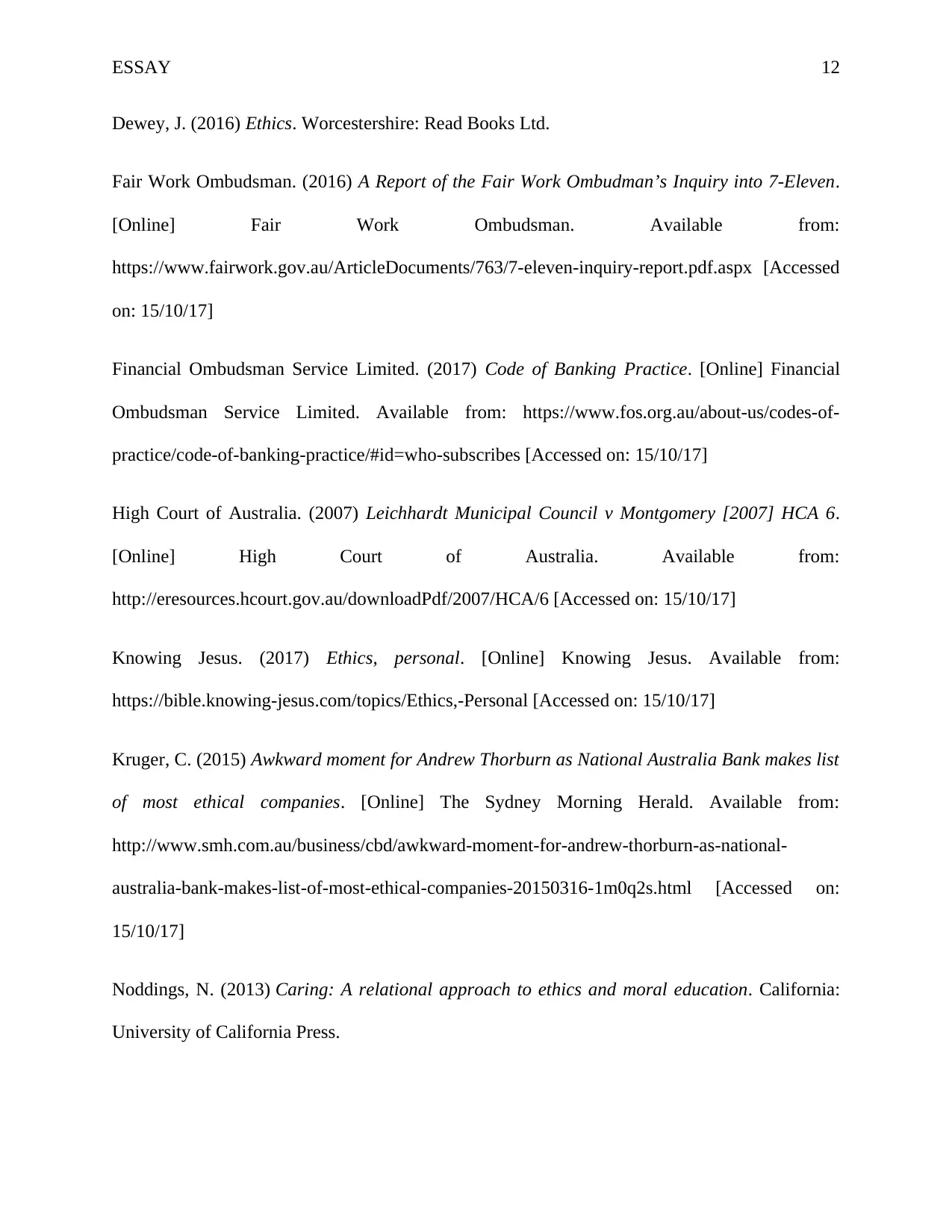
ESSAY 12
Dewey, J. (2016) Ethics. Worcestershire: Read Books Ltd.
Fair Work Ombudsman. (2016) A Report of the Fair Work Ombudman’s Inquiry into 7-Eleven.
[Online] Fair Work Ombudsman. Available from:
https://www.fairwork.gov.au/ArticleDocuments/763/7-eleven-inquiry-report.pdf.aspx [Accessed
on: 15/10/17]
Financial Ombudsman Service Limited. (2017) Code of Banking Practice. [Online] Financial
Ombudsman Service Limited. Available from: https://www.fos.org.au/about-us/codes-of-
practice/code-of-banking-practice/#id=who-subscribes [Accessed on: 15/10/17]
High Court of Australia. (2007) Leichhardt Municipal Council v Montgomery [2007] HCA 6.
[Online] High Court of Australia. Available from:
http://eresources.hcourt.gov.au/downloadPdf/2007/HCA/6 [Accessed on: 15/10/17]
Knowing Jesus. (2017) Ethics, personal. [Online] Knowing Jesus. Available from:
https://bible.knowing-jesus.com/topics/Ethics,-Personal [Accessed on: 15/10/17]
Kruger, C. (2015) Awkward moment for Andrew Thorburn as National Australia Bank makes list
of most ethical companies. [Online] The Sydney Morning Herald. Available from:
http://www.smh.com.au/business/cbd/awkward-moment-for-andrew-thorburn-as-national-
australia-bank-makes-list-of-most-ethical-companies-20150316-1m0q2s.html [Accessed on:
15/10/17]
Noddings, N. (2013) Caring: A relational approach to ethics and moral education. California:
University of California Press.
Dewey, J. (2016) Ethics. Worcestershire: Read Books Ltd.
Fair Work Ombudsman. (2016) A Report of the Fair Work Ombudman’s Inquiry into 7-Eleven.
[Online] Fair Work Ombudsman. Available from:
https://www.fairwork.gov.au/ArticleDocuments/763/7-eleven-inquiry-report.pdf.aspx [Accessed
on: 15/10/17]
Financial Ombudsman Service Limited. (2017) Code of Banking Practice. [Online] Financial
Ombudsman Service Limited. Available from: https://www.fos.org.au/about-us/codes-of-
practice/code-of-banking-practice/#id=who-subscribes [Accessed on: 15/10/17]
High Court of Australia. (2007) Leichhardt Municipal Council v Montgomery [2007] HCA 6.
[Online] High Court of Australia. Available from:
http://eresources.hcourt.gov.au/downloadPdf/2007/HCA/6 [Accessed on: 15/10/17]
Knowing Jesus. (2017) Ethics, personal. [Online] Knowing Jesus. Available from:
https://bible.knowing-jesus.com/topics/Ethics,-Personal [Accessed on: 15/10/17]
Kruger, C. (2015) Awkward moment for Andrew Thorburn as National Australia Bank makes list
of most ethical companies. [Online] The Sydney Morning Herald. Available from:
http://www.smh.com.au/business/cbd/awkward-moment-for-andrew-thorburn-as-national-
australia-bank-makes-list-of-most-ethical-companies-20150316-1m0q2s.html [Accessed on:
15/10/17]
Noddings, N. (2013) Caring: A relational approach to ethics and moral education. California:
University of California Press.
⊘ This is a preview!⊘
Do you want full access?
Subscribe today to unlock all pages.

Trusted by 1+ million students worldwide
1 out of 13
Your All-in-One AI-Powered Toolkit for Academic Success.
+13062052269
info@desklib.com
Available 24*7 on WhatsApp / Email
![[object Object]](/_next/static/media/star-bottom.7253800d.svg)
Unlock your academic potential
Copyright © 2020–2025 A2Z Services. All Rights Reserved. Developed and managed by ZUCOL.
